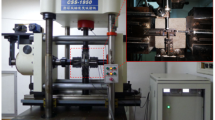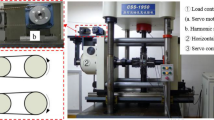Abstract
This paper examines viscosity of rock mass at different structural hierarchies. The study shows that viscosity and characteristic strain rate of rock mass vary at different structural levels. There exists one-to-one correspondence between characteristic scale level and strain rate. High viscosity with low characteristic strain rate occurs under macro-level, while meso- and micro-levels are characterized by low viscosity with high characteristic strain rate. Generally, with the increase in strain rate, deformation and fracture take place at decreasing scale levels, and viscosity gradually decreases. With high characteristic strain rate at meso- and micro-levels, viscosity is inversely proportional to strain rate at these levels. Based on the analysis on viscosity at different structural levels, a unified description of viscosity is suggested and applied to the description of the strength–strain rate sensitivity of rock mass.













Similar content being viewed by others
References
Anderson O, Grew P (1977) Stress corrosion theory of crack propagation with application to geophysics. Rev Geophys Space Phys 15:77–104
Ando R, Yamashita T (2007) Effects of mesoscopic-scale fault structure on earthquake ruptures: dynamic formation of geometrical complexity of earthquake faults. J Geophys Res 112:B09303. doi:10.1029/2006JB004612
Altshuler LV, Doronin GS, Kim GKh (1987) Viscosity of shock compressed liquids. App Mech Tech Phys 28(6):110–118
Atkinson B (1984) Subcritical crack growth in geological materials. J Geophys Res 89:4077–4114
Atkinson B, Meredith P (1987) The theory of subcritical crack growth with application to minerals and rocks. In: Atkinson BK (ed) Fracture mechanics of rock. Academy Press, New York, pp 111–166
Barton CC (1995) Fractal analysis of scaling and spatial clustering of fractures. In: Barton CC, Lapointe PR (eds) Fractal in the earth science. Plenum Press, New York, pp 141–178
Belinsky IV, Khristoforov BD (1968) Viscosity of NaCl under shock compression. Appl Mech Tech Phys 9(1):150–151
Belinsky IV, Mikhaliuk AV, Khristoforov BD (1975) Viscosity of rock mass in deformation processes. Phys Solid Earth 11(8):80–84
Bieniawski ZT (1967) Mechanism of brittle fracture of rock: part I theory of fracture process. Int J Rock Mech Min Sci Geomech Abstr 4(4):395–406
Bird RB, Armstrong RC and Hassager O (1987) Dynamics of polymeric liquid, vol. 2, 2-nd ed. Wiley, New York
Broberg KB (1999) Cracks and Fracture. Academic Press, San Diego
CEB (1993) CEB-FIP model code 1990. Committee Euro-International Du Beton, Redwood Books, Trowbridge, Wiltshire
Chekunaev NI, Kaplan AM (2009) Limiting speed of crack propagation in elastic materials. J Appl Mech Tech Phys 50(4):677–683
Chow TS (2000) Mesoscopic physics of complex materials. Springer, New York
Dove PM (1995) Geochemical controls on the kinetics of quartz fracture at subcritical tensile stresses. J Geophys Res 100:22349–22359
Dulaney EN, Brace WF (1960) Speed behavior of a growing crack. J Appl Phys 31(12):2233–2236
Faulkner D, Jackson CAL, Lunn RJ, Schlische RW, Shiptone ZK, Wibberley CAJ, Withjack MO (2010) A review of recent developments concerning the structure, mechanics and fluid flow properties of fault zones. J Struct Geol 32(11):1557–1575
Field JE (1971) Brittle fracture: its study and application. Comtemp Phys 12(1):1–31
Fineberg J, Marder M (1999) Instability in dynamic fracture. Phys Rep 313:101–108
Finkel VM (1962) Investigation on crack growth under dynamic fracture of glass. Phys Solid State 4(6):1412–1418
Freiman S (1984) Effects of chemical environments on slow crack growth in glasses and ceramics. J Geophys Res 89:4072–4076
Freund LB (1990) Dynamic fracture mechanics. Cambridge University Press, Cambridge
Grady DE (1996) Shock wave properties of brittle solids. In: Schmidt Steve (ed) Shock compression of condensed matters, 9–20. AIP Press, New York
Grady DE (2008) Fragment size distribution from the dynamic fragmentation of brittle solids. Int J Impact Eng 35(12):1557–1562
Grady DE (2010) Length scale and size distribution in dynamic fragmentation. Int J Fract 63:85–99
Grady DE, Hollebach RE, Schuler KW, Callender JF (1977) Strain rate dependence in Dolomite inferred from impact and static compression rests. J Geophs Res 82:1325–1333
Hadley K (1976) Comparison of computed and observed crack densities and seismic velocities in Westerly granite. J Geophys Res 81:3484–3494
Hong L, Li XB, Ma C, Yin TB, Ye ZY, Liao GY (2008) Study on size effect of rock dynamic strength and strain rate sensitivity. Chin J Rock Mech Eng 27(3):526–533
Horie Y, Yano K (2002) Non-equilibrium fluctuations in shock compression of polycrystalline α-iron. In: Furnish MD (ed) Shock compression of condensed matter-2001. AIP, New York, pp 553–556
Housen KR, Holsapple KA (1999) Scale effects in strength-dominated collisions of rocky asteroids. Icarus 142:21–33
Kipp ME, Grady DE (1985) Dynamic fracture growth and interaction in one dimension. J Mech Phys Solids 33(4):399–415
Kipp ME, Grady DE, Chen EP (1980) Strain-rate dependent fracture initiation. Int J Fract 16:471–478
Kocharyan GG (2014) Scale effect in seismotectonics. Geodyn Tectonophys 5(2):353–385. doi:10.5800/GT2014520133
Kocharyan GG, Kulyukin AA, Markov VK, Markov DV, Pavlov DV (2005) Small disturbances and stress-strain state of the Earth’s crust. Phys Mesomech 8(1):23–36
Kuksenko VS (1987) Physical and methodological fundament for prediction of rock-bursts. J Min Sci 23(1):9–22
Kurlenia MV, Oparin VN (1996) Scale factor of phenomenon of zonal disintegration of rock and canonical series of atomic and ionic radii. J Min Sci 32(2):81–90
Kurlenia MV, Oparin VN, Eremenko AA (1993) Relation of linear block dimensions of rock to crack opening in the structural hierarchy of masses. J Min Sci 29(3):197–203
Landau LD, Lifshitz EM (1959) Theory of elasticity. Pergamon, London
Lawn BR, Wilshaw TR (1975) Fracture of brittle solids. Cambridge University Press, Cambridge
Lee J (2002) The universal role of turbulence in the propagation of strong shocks and detonation waves. In: Horie Y (ed) High-pressure shock and compression of solids VI. Springer, Berlin, pp 121–148
Lindholm US, Yeakley LM, Nagy A (1974) The dynamic strength and fracture properties of Dresser basalt. Int J Rock Mech Min Sci Geomech Abstr 11(5):181–191. doi:10.1016/0148-9062(74)90885-7
Lockner DA, Moore RM, Reches Z (1992) Microcrack interaction leading to shear failure. In: Tillerson JR, Wawersik WR (eds) Rock Mechanics, Proceedings of the 33rd US Symposium. Balkema, The Netherland, pp 807–817
Lysak SV, Levi KG (1992) Continental rift zone patterns and their geophysical fields. In: Logatchev NA (ed) Faulting in lithosphere, extensional zones. Nauka, Siberian Branch, Novosibirsk, pp 6–21
Moore RM, Lockner DA (1995) The role of microcracking in shear fracture propagation in granite. J Struct Geol 17:95–114
Mott NF (1948) Brittle fracture in mild steel plates. Engineering 165:16–18
Oparin VN, Yushkin VF, Akinin AA, Balmashnov EG (1998) A new scale of hierarchically structured representations as a characteristic for ranking entities in a geomedium. J Min Sci 34(5):387–401
Ožbolt J, Rah KK, Mestrović D (2006) Influence of loading rate on concrete cone failure. Int J Frac 139:239–252
Panin VE (1998) Physical mesomechanics of heterogeneous media and computer-aided design of materials. Cambridge Int Sci Pub, Cambridge
Petrov VA (1984) Lifetime of solids under low loads-nonfracturing stresses. Phys Solid State 26(7):2116–2119
Perzyna P (1998) Constitutive modeling of dissipative solid for localization and fracture. localization and fracture phenomena in inelastic solids. Springer, Wien, New York, pp 99–241
Piggot AR (1997) Fractal relations for the diameter and trace length of disc-shaped fractures. J Geophys Res 102:18121–18125
Popov VL, Kröner E (2001) Theory of elastoplastic media with mesostructure. Theo App Fra Mech 37(1–3):299–310
Qi CZ, Qian QH (2003) Physical mechanism of brittle material strength-strain rate sensitivity. Chin J Rock Mech Eng 21(2):177–181
Qi CZ, Qian QH (2009) Basic problems of dynamic deformation and fracture of rock mass. Science Press, Beijing
Qi CZ, Wang MY, Bai JP, Li KR (2014) Mechanism underlying dynamic size effect on rock mass strength. Int J Impact Eng 68:1–7
Chengzhi Qi, Mingyang Wang, Qihu Qian, Jianjie Chen (2008) Structural hierarchy of rock masses and the mechanisms of its formation. Moscow University Mech Bull 63(5):113–121. doi:10.3103/S0027133008050026
Radionov VN, Sizov IA, Tsvetkov VM (1986) Fundamental of geomechanics. Nedra, Moscow
Rahiman TIH, Pettinga JR (2009) Fracture lineaments, fault mesh formation and seismicity: towards a seismotectonic model for Viti Levu, Fiji. Bull New Zealand Soc Earth Eng 42(1):63–72
Roberts DK, Wells AA (1954) The speed of brittle fracture. Engineering 24:820–821
Rosakis AJ, Samudrala O, Coker D (1999) Cracks faster than the shear wave speed. Science 284:1337–1340
Rouleau A, Gale JE (1985) Statistical characterization of the fracture system in the Stripa granite. Int J Rock Mech Min Sci Geomech Abstr 22:353–367
Sadovsky MA, Bolkhovitinov LG, Pisarenko VF (1987) Deformation of geophysical medium and seismic process. Publishing house “Nauka”, Moscow (In Russian)
Sadovsky MA, Pisarenko VF (1983) On dependence of preparation time of earthquake on its energy. Rep Acad Sci USSR 271(2):330–333
Sadovsky MA, Pisarenko VF, Shteinberg VV (1983) On dependence of energy of earthquake on earthquake source volume. Rep Acad Sci USSR 271(3):598–602
Salganik R, Rapoport L, Gotlib VA (1997) Effect of structure on environmentally assisted subcritical crack growth in brittle materials. Int J Fract 87:21–46
Savage HM, Brodsky EE (2011) Collateral damage: Evolution with displacement of fracture distribution and secondary fault strands in fault damage zones. J Geophys Res 116(B3):B03405
Scholz CH, Dawers NH, Yu JZ, Anders MH, Cowie PA (1993) Fault growth and scaling laws: preliminary results. J Geophys Res 98:21951–21961
Senseny PE, Hansen FD, Russell JE, Carter NL, Hardin JW (1992) Mechanical behavior of rock salt: Phenomenology and micro-mechanism. Int J Rock Mech Min Sci Geomech Abstr 29(4):363–378
Sherman SI (1992) The relationships between quantitative parameters of faults. In: Logatchev NA (ed) Faulting in lithosphere, extensional zones. Nauka, Siberian Branch, Novosibirsk, pp 78–102
Sherman SI (2012) Destruction of the lithosphere: fault-block divisibility and its tectonophysical regularities. Geophys Tectonophys 3(4):315–344
Shibi T, Kamei T (2008) Investigation of the mechanism of fault formation using bifurcation analysis. In: Proceedings of the eighteenth international offshore and polar engineering conference, 654–659. Vancouver, BC, Canada, July 6–11
Sih GC (2008) Birth of mesomechanics arising from segmentation and multiscaling: nano-micro-macro. Phys Mesomech 11(3–4):128–140
Spahn F, Neto EV, Guimaraes AHF, Gorban AN, Brilliantov NV (2011) A statistical model of aggregates fragmentation. Eprint arXiv: 1106.2721lvl [cond-mat-stat-mech] 14 Jun 2011
Stepanov GV, Kharchenko VV (1984) Relation between stress and strain in metals under impulsive action. Probl Strength 11:32–37
Steverding B, Lehnigk SH (1970) Response of cracks to impact. J Appl Phys 41(5):2096–2099
Tyapkin KF, Kiveliuk TT (1982) Investigation of fault structure by geological-geophysical methods. Nedra, Moscow
Wang TM (2006) Control of cracking in engineering structures. China Architecture & Building Press, Beijing
Yavari A, Khezrzadeh H (2010) Estimating terminal speed of rough cracks in the framework of discrete fractal fracture mechanics. Eng Fra Mech 77(10):1516–1526
Yoffe EH (1951) The moving Griffith crack. Phil Mag 42:739–750
Zhurkov SN (1965) Kinetic concept of the strength of solids. Int J Fract 1(4):311–322
Acknowledgments
The study was financially supported in part by the National Natural Science Foundation of China (Nos. 51174012 and 51478027), the Project of Construction of Innovative Teams and Teacher Career Development for Universities and Colleges Under Beijing Municipality (No. IDHT20130512), the “973” Key State Research Program (Grant No. 2015CB0578005), Science Fund for Creative Research Groups of the National Natural Science Foundation of China (No. 51021001), as well as Development of High-Caliber Talents Project of Beijing Municipal Institutions granted to Dr. Jilin Qi (No. CIT&TCD20150101).
Author information
Authors and Affiliations
Corresponding author
Rights and permissions
About this article
Cite this article
Qi, C., Haoxiang, C., Bai, J. et al. Viscosity of rock mass at different structural levels. Acta Geotech. 12, 305–320 (2017). https://doi.org/10.1007/s11440-016-0449-5
Received:
Accepted:
Published:
Issue Date:
DOI: https://doi.org/10.1007/s11440-016-0449-5




